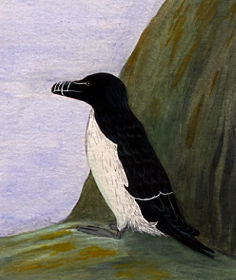Overview
 Order: Charadriiformes
Order: Charadriiformes
Family: Alcidae
Species: Alca torda
IUCN Status: Near Threatened
Population Trend: decreasing
Distribution: North Atlantic, breeding on coasts from western Greenland to New England (U.S.A.), Bear Island to Brittany. In winter, northern populations move south, some spreading into the Mediterranean as far as Italy. Present all year round in Britain.
Habitat: mainly coastal & offshore waters, breeding on sea cliffs etc.
Description: plumply built, penguin-like bird with black head & upperparts, white bar on hindwing, white underparts. Large, flattened black bill crossed with a line of white vertically across middle. Also white line from bill to near eye.
Size: 40cm (16in) in length.
Food: fish, crustaceans etc.
Razorbills belong to the auk family, along with guillemots and puffins. They look rather similar to guillemots but their dark feathers are black rather than chocolate brown, they are plumper and have thicker, heavier-looking bills. On the water, a razorbill floats higher than a guillemot and its longer tail tilts upwards.
The razorbill is well-named because the edges of its hooked upper beak are very sharp indeed, enabling it to grasp fish well and to defend itself against predators.
Feeding
Razorbills eat mainly fish such as sand eels but they also eat molluscs (snail-like creatures), crustaceans (crabs etc.) and planktonic worms. Fish are carried crosswise in the bill, in the same way as the puffin does. Up to eight fish can be carried at once. Razorbills, guillemots and puffins do not compete directly for food because guillemots catch large fish, which they carry singly; puffins catch small fish and razorbills catch medium-sized fish.
Swimming & Flying
Swimming:
Razorbills spend much of the year well out to sea. They often swim in 'rafts', bobbing up and down in the swell. As with other auks, they are expert underwater swimmers, using their wings.
Flying:
A razorbill takes off from the water rather clumsily, feet pattering along the surface, but then it flies strongly with rapid wing-beats. During the late summer, the birds moult all their flight feathers at the same time, making them unable to fly for a while.
Breeding
Razorbills nest in colonies in remote, sheltered holes and crevices in cliffs, among boulders on rocky foreshores; sometimes they choose a puffin hole but only very rarely use exposed ledges chosen by guillemots.
The birds arrive at their colonies from the end of January onwards, but breeding begins in earnest in April. No real nest is made, except sometimes a few plants or stones are used. A courting pair may be seen in the so-called 'ecstatic' pose, where one bird stretches its beak up into the air, making a grating noise with bill parted, while its mate nibbles its throat.
A single egg is laid from early May onwards and both parents incubate it for 33 - 36 days, then share the feeding duties. At about 18 days old, the still down-covered chick launches itself from the cliff, fluttering down on tiny wings, usually at night to avoid predatory gulls. They often fall onto rocks or into heavy surf but they are well protected by fat and feathers and can swim strongly. Their parents continue to feed them out at sea until they can fly and fend for themselves.
Razorbills and Humans
The auks, particularly razorbills and guillemots, are the seabirds most seriously affected by oil pollution, probably because they spend more time on the water than gulls or cormorants which feed at sea but return to land to roost. The auks are also more likely to dive when in trouble, so collect more oil on their feathers. Regular oil spillages over the last 30 years or so have probably been gradually decreasing their numbers although recently A BBC on line article of August 2014 says the Razorbills had had a good season and were doing well.
Another problem which has come to light recently is starvation. Razorbills, guillemots and puffins have been dying in their hundreds, unable to find sufficient fish to sustain them through the winter. Overfishing of the North Sea waters by humans is depriving the birds of their natural prey.
Credits
Image: Razorbill by C. E. Timothy Paine
Information sourced from:
BBC News (2014) Puffins, shags and razorbills doing well, says NTS [online], Available from: http://www.bbc.co.uk/news/uk-scotland-highlands-islands-28806170 [accessed 23/07/2015].
 Order: Charadriiformes
Order: Charadriiformes
